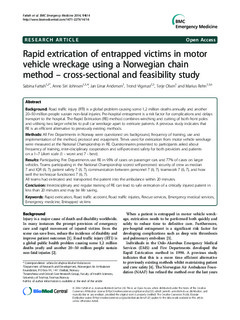| dc.contributor.author | Fattah, Sabina | |
| dc.contributor.author | Johnsen, Anne Siri | |
| dc.contributor.author | Andersen, Jan Einar | |
| dc.contributor.author | Vigerust, Trond | |
| dc.contributor.author | Olsen, Terje | |
| dc.contributor.author | Rehn, Marius | |
| dc.date.accessioned | 2016-04-07T09:35:21Z | |
| dc.date.available | 2016-04-07T09:35:21Z | |
| dc.date.issued | 2014-07 | |
| dc.identifier.citation | Fattah, S. et al. (2014) Rapid extrication of entrapped victims in motor vehicle wreckage using a Norwegian chain method – cross-sectional and feasibility study. BMC Emergency Medicine , 14:14 | nb_NO |
| dc.identifier.uri | http://hdl.handle.net/11250/2384395 | |
| dc.description | This article was originally published in BMC Emergency Medicine. This is an Open Access article distributed under the terms of the Creative
Commons Attribution License (http://creativecommons.org/licenses/by/2.0), which permits unrestricted use, distribution, and
reproduction in any medium, provided the original work is properly credited. | nb_NO |
| dc.description.abstract | Background
Road traffic injury (RTI) is a global problem causing some 1,2 million deaths annually and another 20–50 million people sustain non-fatal injuries. Pre-hospital entrapment is a risk factor for complications and delays transport to the hospital. The Rapid Extrication (RE) method combines winching and cutting of both front poles and utilising two larger vehicles to pull car wreckage apart to extricate patients. A previous study indicates that RE is an efficient alternative to previously existing methods.
Methods
All Fire Departments in Norway were questioned on: background, frequency of training, use and implementation of the method, protocol and equipment. Times used for extrication from motor vehicle wreckage were measured at the National Championship in RE. Questionnaires presented to participants asked about frequency of training, inter-disciplinary cooperation and self-perceived safety for both providers and patients on a 1–7 Likert scale (1 - worst and 7 - best).
Results
Participating Fire Departments use RE in 95% of cases on passenger cars and 77% of cases on larger vehicles. Teams participating in the National Championship scored self-perceived security of crew as median 7 and IQR (6, 7), patient safety 7 (6, 7), communication between personnel 7 (6, 7), teamwork 7 (6, 7), and how well the technique functioned 7 (6, 7).
All teams had extricated and transported the patient into the ambulance within 20 minutes.
Conclusion
Interdisciplinary and regular training of RE can lead to safe extrication of a critically injured patient in less than 20 minutes and may be life saving. | nb_NO |
| dc.language.iso | eng | nb_NO |
| dc.publisher | BioMed Central | nb_NO |
| dc.rights | Navngivelse 3.0 Norge | * |
| dc.rights.uri | http://creativecommons.org/licenses/by/3.0/no/ | * |
| dc.subject | akuttmedisin | nb_NO |
| dc.subject | rapid extrication | nb_NO |
| dc.subject | emergency medicine | nb_NO |
| dc.subject | road traffic accident | nb_NO |
| dc.subject | veiulykker | nb_NO |
| dc.subject | road traffic injuries | nb_NO |
| dc.subject | rescue services | nb_NO |
| dc.subject | emergency medical services | nb_NO |
| dc.title | Rapid extrication of entrapped victims in motor vehicle wreckage using a Norwegian chain method – cross-sectional and feasibility study | nb_NO |
| dc.type | Journal article | nb_NO |
| dc.type | Peer reviewed | nb_NO |
| dc.rights.holder | © 2014 Fattah et al. | nb_NO |
| dc.subject.nsi | VDP::Medical disciplines: 700::Clinical medical disciplines: 750 | nb_NO |
| dc.source.journal | BMC Emergency Medicine | nb_NO |
| dc.identifier.doi | 10.1186/1471-227X-14-14 | |

